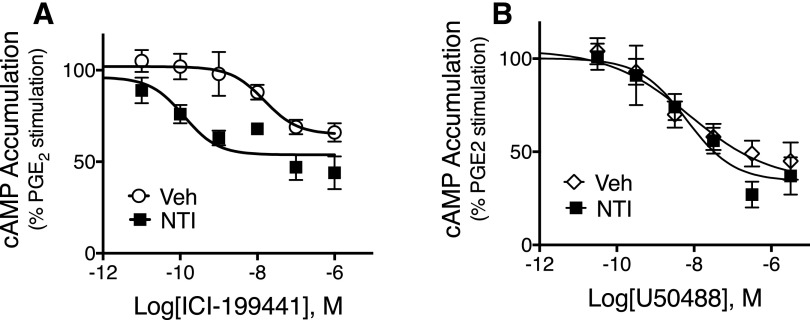Fig. 1.
Ligand-dependent effects of the DOR antagonist naltrindole (NTI) on concentration–response curves for the KOR agonists (A) ICI-199441 and (B) U50488 for inhibition of PGE2-stimulated cAMP accumulation. Primary cultures of peripheral sensory neurons were pretreated with NTI (20 nM) or vehicle (Veh) for 15 minutes. After pretreatment, cells were treated with various concentrations of ICI-199441 or U50488, along with PGE2 (1 μM) and the phosphodiesterase inhibitor rolipram. Cellular cAMP levels were measured after 15 minutes. Data are expressed as the percentage of PGE2-stimulated cAMP levels and represent the mean ± S.E.M (n = 5). In the presence of NTI, the curve to ICI-199441 (A) was shifted to the left (F(1,56) = 21.65, P < 0.0001). By contrast, NTI did not alter the curve to U50488 (B) (F(1,56) = 0.217, P = 0.64). (A) Basal cAMP levels were 0.51 ± .07 pmol/well versus 0.45 ± 0.07 pmol/well, Veh and NTI, respectively, and PGE2-stimulated cAMP levels were 217% ± 45% above basal and 241% ± 22% above basal Veh and NTI, respectively (mean ± S.E.M., n = 5). (B) Basal cAMP levels were 0.80 ± 0.16 pmol/well versus 0.91 ± 0.19 pmol/well, Veh and NTI, respectively, and PGE2-stimulated cAMP levels were 186% ± 33% above basal and 130% ± 26% above basal, Veh and NTI, respectively (mean ± S.E.M., n = 5). As shown in Supplemental Fig. 1, NTI (20 nM) completely antagonized a maximal concentration of DPDPE (100 nM) for inhibition of cAMP accumulation, indicating full occupancy of DOR at this concentration.

